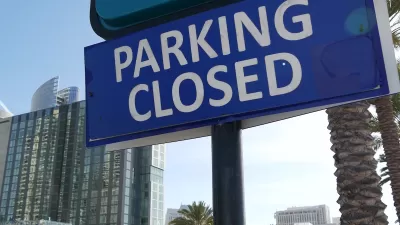Surface parking lots take up as much as a third of downtown land in some cities, dragging down tax revenue and redevelopment prospects.

In an opinion piece in The Washington Post, Travis Meier calls on cities to enact policies that promote the redevelopment of the many underused or vacant surface parking lots that occupy, on average, one-quarter of land in American city centers. “Our nation’s downtowns are full of these neglected spaces — surface lots of crumbling asphalt and weeds, emblematic of absentee property owners and a disregard for the public good. Other lots, not entirely abandoned, are often underused and unkept.”
According to Meier, “City centers need density and connection; surface parking lots destroy both.” When it comes to local tax revenue, surface parking lots are also a losing proposition for cities, limiting tax revenue and slowing down the development process. “The lot is assessed at a low rate, so corporations and landowners sit on their cheap land, waiting years for a top-dollar bidder as downtown real estate gets more expensive.”
One proposal that would spur more development of vacant parking lots is a land value tax, which assesses properties based on potential value, thus eliminating the incentive for owners to sit on the land. “City leaders should also encourage land sales by actively seeking buyers, offering financial incentives and reorienting preexisting blight programs.”
FULL STORY: Opinion: Empty parking lots are a drag on America’s downtowns

Alabama: Trump Terminates Settlements for Black Communities Harmed By Raw Sewage
Trump deemed the landmark civil rights agreement “illegal DEI and environmental justice policy.”

Planetizen Federal Action Tracker
A weekly monitor of how Trump’s orders and actions are impacting planners and planning in America.

Why Should We Subsidize Public Transportation?
Many public transit agencies face financial stress due to rising costs, declining fare revenue, and declining subsidies. Transit advocates must provide a strong business case for increasing public transit funding.

Understanding Road Diets
An explainer from Momentum highlights the advantages of reducing vehicle lanes in favor of more bike, transit, and pedestrian infrastructure.

New California Law Regulates Warehouse Pollution
A new law tightens building and emissions regulations for large distribution warehouses to mitigate air pollution and traffic in surrounding communities.

Phoenix Announces Opening Date for Light Rail Extension
The South Central extension will connect South Phoenix to downtown and other major hubs starting on June 7.
Urban Design for Planners 1: Software Tools
This six-course series explores essential urban design concepts using open source software and equips planners with the tools they need to participate fully in the urban design process.
Planning for Universal Design
Learn the tools for implementing Universal Design in planning regulations.
Caltrans
Smith Gee Studio
Institute for Housing and Urban Development Studies (IHS)
City of Grandview
Harvard GSD Executive Education
Toledo-Lucas County Plan Commissions
Salt Lake City
NYU Wagner Graduate School of Public Service





























